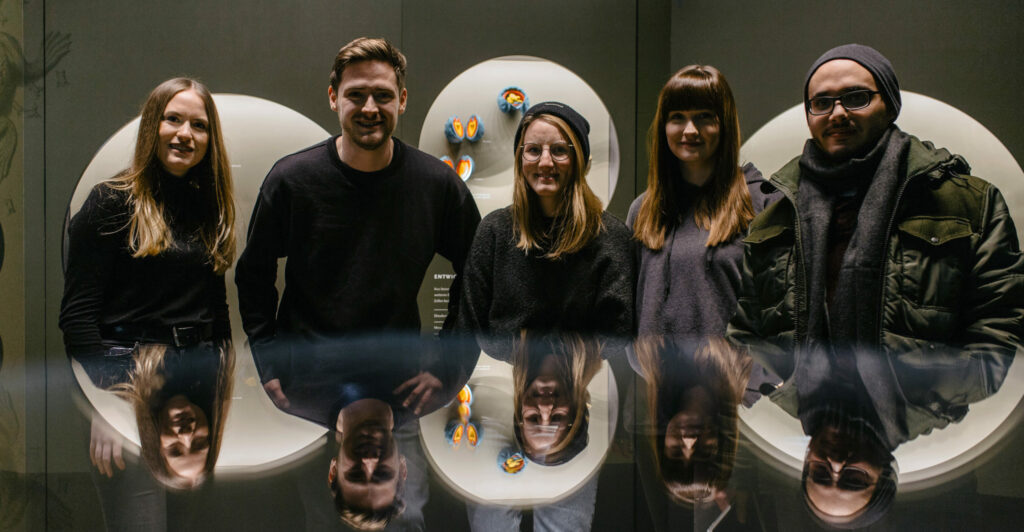Aquazoo Augmented
Introduction
Aquazoo Augmented enhances the educational experience at Aquazoo Düsseldorf using Augmented Reality (AR). The project digitally augments exhibits to create an interactive learning environment. A multidisciplinary team developed an AR prototype focusing on the frog’s anatomy, presented in layered digital representations. This AR application increases visitor engagement and educational value, showcasing the effective integration of digital technology in traditional educational settings.
Project Background
Aquazoo Düsseldorf: Established in 1987, Aquazoo is not just a place to see animals; it’s a gateway to understanding the intricate web of life. Through its extensive aquariums and exhibits, visitors embark on a journey through biological diversity, gaining scientific insights that are both profound and engaging.
Motivation and Objectives: The zoo wanted to push the boundaries of traditional exhibits. Our mission was to enhance this experience with digital technology, making learning more interactive and captivating. We aimed to create an AR application that would engage visitors, especially school groups, in new and exciting ways.
Project Objectives
• Digital Enhancement: Introduce a digital layer to existing exhibits using AR to create an immersive learning experience.
• User Engagement: Increase visitor interaction and engagement through interactive digital content.
My Role
• Project Coordination: Managed project timelines, team collaboration, and overall execution.
• User Experience Design: Developed the UX design to ensure an intuitive and engaging user experience.
• Prototyping: Created the interface design to facilitate seamless interaction between users and the AR elements.

Research and Analysis
Visitor Experience: We immersed ourselves in the zoo experience, observing visitors and conducting interviews with staff. These insights were crucial in understanding how to enhance the educational impact of the exhibits.
Technical Feasibility: We assessed various exhibits to determine their suitability for AR enhancement, considering factors like visibility, interaction potential, and technical constraints.

Concept Development
• Brainstorming: Conducted idea generation sessions to explore various concepts.
• Conceptualization: Developed a concept focusing on presenting the frog’s anatomy in layered digital representations, enhancing educational value.
3D and Visualization
• 3D Modeling: Created scientifically accurate 3D models of the frog’s anatomy using photogrammetry scans for precision.
• Spatial Integration: Ensured correct spatial placement of 3D models within the physical environment, allowing users to interact with them seamlessly.
Interface Design
• UI Approaches: Developed and tested both 2D and spatial interface designs, incorporating user feedback to select the most effective approach.
• Iterative Refinement: Iteratively refined the interface based on user testing, focusing on usability and engagement.
Development Process
• 3D Scanning: Conducted photogrammetry scans to create accurate 3D models of the exhibit.
• Content Creation: Modeled anatomical structures in Cinema 4D, ensuring scientific accuracy and performance optimization.
• Tracking Technology: Implemented 2D tracking due to the complexity and lighting conditions affecting 3D tracking reliability.
• App Development: Utilized Unity for app development, integrating virtual trackers and 3D models, and deploying for Android and iOS.
Evaluation and Testing
• Usability Testing: Conducted tests with zoo visitors, gathering qualitative data to identify and address usability issues.
• Feature Enhancement: Added a scaling feature for smaller anatomical models to enhance visibility and user interaction.
Final Product and Results
• AR Application: Successfully developed and deployed an AR app that enriches the visitor experience at Aquazoo.
• User-Centric Design: Ensured high usability, making the app accessible even to young visitors.
• Impact: Demonstrated significant improvements in visitor engagement and educational value.
Lessons Learned
Timing!Timing!Timing: Early collaboration and focused efforts helped in meeting deadlines and identifying use cases promptly.
KeepItSimple: The MVP approach prioritized essential features and facilitated clear stakeholder communication.
DefineBuildTestIterate: Iterative cycles of development and user testing provided valuable insights, enhancing the quality and relevance of the product.
TrustYourTeam: Distributed responsibilities enabled efficient parallel processes, reducing coordination overhead and maintaining a strong product focus.
